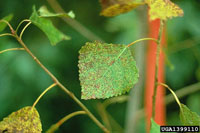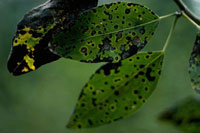Septoria (Mycosphaerella) spp., Marssonina spp.
Hosts
Septoria leaf spot- poplar, caragana, maple
Marssonina leaf spot- poplar, aspen
Distribution and Disease Cycle

Photo credit: Manfred Mielke, USDA Forest Service, Bugwood.org
Marsonnia leaf spots spores are released in spring and early summer from fruiting bodies that overwintered on fallen leaves or infected shoots. These spread by wind and rain to newly emerging leaves or young shoots. In summer and fall, spores produced on leaf and stem lesions spread to other plants and cause secondary infections. Repeated outbreaks can cause branch dieback and make trees susceptible to infection by other pathogens or pests. Septoria fruiting bodies also overwinter on infected leaves and twigs, releasing spores in spring to infect leaves on lower branches. During rainy periods in summer, another type of spore is released from current infections to produce secondary infections.
Symptoms and Signs

Photo credit: Natural Resources Canada, Canadian Forestry Service
Marssonina leaf spot appears as dark brown flecks with yellow margins on newly emerged leaves enlarging to form necrotic blotches. Diseased leaves are typically smaller and may be shed prematurely. The disease usually begins in lower branches, moving upward into the crown. When moisture and humidity are high, infections can become severe leading to yellowing and premature defoliation of leaves.
Septoria symptoms can vary depending on the timing of infection, host and age of leaf. They can be brown circular leaf spots with brown or yellow margins, reddish-tan to brown spots, small flecks with angular margins, white or silver spots, or irregularly shaped large spots that can spread to consume entire leaves. Septoria musiva can also cause cankers on stems, with multiple infections girdling stems.
Control
Prune and destroy cankered branches and remove fallen leaves. If propagating, take cuttings from disease-free shoots. Plant resistant or tolerant varieties and space trees to provide good aeration.. Fungicides containing chlorothalonil or thiophanate-methyl are registered for control of Marssonina leaf spot on poplar. Fungicides containing thiophanate-methyl are registered for control of Septoria leaf spot on poplar. Apply thiophante-methyl 2-3 times per season at 10 day intervals beginning in mid June. Apply chlorothalonil begging at spring bud break and repeat every 7-14 days until conditions no longer favour disease development.